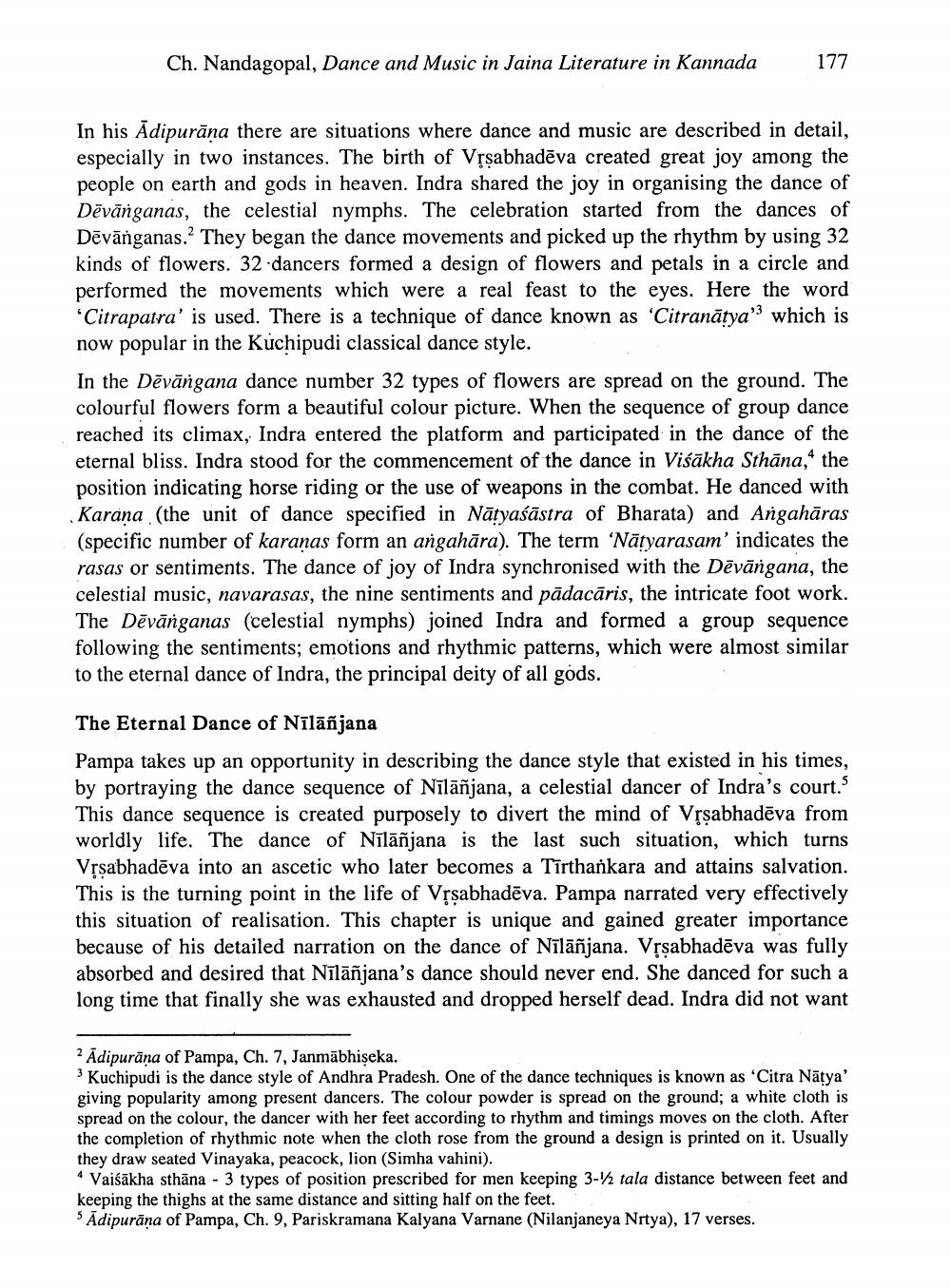________________
Ch. Nandagopal, Dance and Music in Jaina Literature in Kannada
177
In his Ādipurāna there are situations where dance and music are described in detail, especially in two instances. The birth of Vrsabhadēva created great joy among the people on earth and gods in heaven. Indra shared the joy in organising the dance of Dēvānganas, the celestial nymphs. The celebration started from the dances of Dēvānganas. They began the dance movements and picked up the rhythm by using 32 kinds of flowers. 32 dancers formed a design of flowers and petals in a circle and performed the movements which were a real feast to the eyes. Here the word 'Citrapatra' is used. There is a technique of dance known as 'Citranātya” which is now popular in the Kuchipudi classical dance style. In the Dēvāngana dance number 32 types of flowers are spread on the ground. The colourful flowers form a beautiful colour picture. When the sequence of group dance reached its climax, Indra entered the platform and participated in the dance of the eternal bliss. Indra stood for the commencement of the dance in Viśākha Sthāna, the position indicating horse riding or the use of weapons in the combat. He danced with Karana (the unit of dance specified in Nātyaśāstra of Bharata) and Angahāras (specific number of karanas form an angahāra). The term 'Nātyarasam' indicates the rasas or sentiments. The dance of joy of Indra synchronised with the Dēvāngana, the celestial music, navarasas, the nine sentiments and pādacāris, the intricate foot work. The Dīvānganas (celestial nymphs) joined Indra and formed a group sequence following the sentiments; emotions and rhythmic patterns, which were almost similar to the eternal dance of Indra, the principal deity of all gods.
The Eternal Dance of Nīlāñjana Pampa takes up an opportunity in describing the dance style that existed in his times, by portraying the dance sequence of Nīlāñjana, a celestial dancer of Indra's court. This dance sequence is created purposely to divert the mind of Vșşabhadēva from worldly life. The dance of Nīlāñjana is the last such situation, which turns Vrsabhadēva into an ascetic who later becomes a Tīrthankara and attains salvation. This is the turning point in the life of Vrsabhadēva. Pampa narrated very effectively this situation of realisation. This chapter is unique and gained greater importance because of his detailed narration on the dance of Nīlāñjana. Vrsabhadēva was fully absorbed and desired that Nīlāñjana's dance should never end. She danced for such a long time that finally she was exhausted and dropped herself dead. Indra did not want
2 Adipurāna of Pampa, Ch. 7, Janmābhiseka. 3 Kuchipudi is the dance style of Andhra Pradesh. One of the dance techniques is known as 'Citra Nātya' giving popularity among present dancers. The colour powder is spread on the ground; a white cloth is spread on the colour, the dancer with her feet according to rhythm and timings moves on the cloth. After the completion of rhythmic note when the cloth rose from the ground a design is printed on it. Usually they draw seated Vinayaka, peacock, lion (Simha vahini). * Vaišākha sthāna - 3 types of position prescribed for men keeping 3-2 tala distance between feet and keeping the thighs at the same distance and sitting half on the feet. s Adipurāņa of Pampa, Ch. 9, Pariskramana Kalyana Varnane (Nilanjaneya Nrtya), 17 verses.




